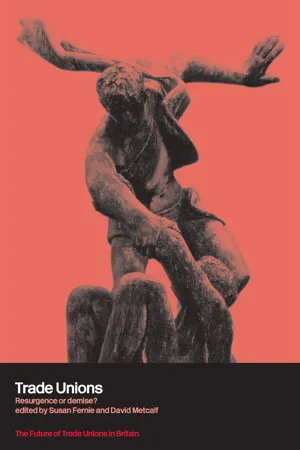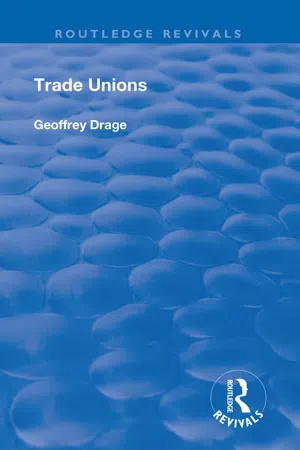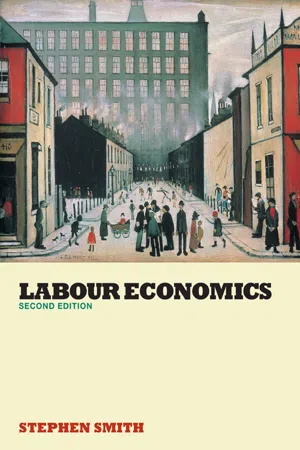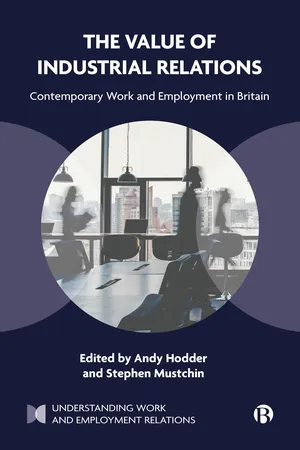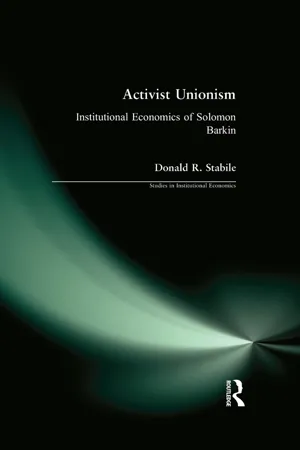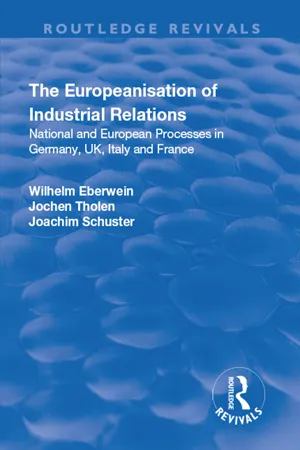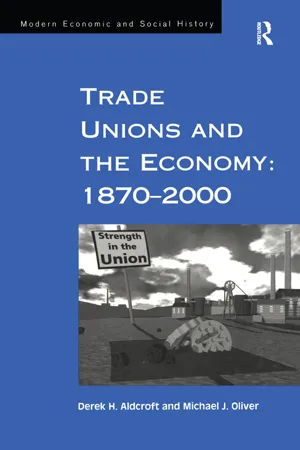Economics
Trade Unions and Wages
Trade unions are organizations formed by workers to protect their rights and improve working conditions. They negotiate with employers on behalf of their members to secure better wages, benefits, and working hours. By collectively bargaining for higher wages, trade unions can influence the overall wage levels in an industry or sector.
Written by Perlego with AI-assistance
Related key terms
Related key terms
1 of 4
Related key terms
1 of 3
10 Key excerpts on "Trade Unions and Wages"
- eBook - ePub
Understanding European Trade Unionism
Between Market, Class and Society
- Richard Hyman(Author)
- 2001(Publication Date)
- SAGE Publications Ltd(Publisher)
One of the strongest objections to this view was articulated by Selig Perlman (1928). His argument was that American unionism, with its concentration on directly job-related issues, displayed greater maturity than its more politicized European counterparts. Effective trade unionism was a means of collective response to the economic vulnerability described by the Webbs, pursuing workers’ aspirations ‘for a decent livelihood, for economic security, and for freedom from tyranny on the part of the boss’ by securing their common ‘job-territory’ (1928: 273–4). The pursuit of limited but attainable economic objectives, attuned to workers’ direct experiences in the labour market and at work, was for Perlman the only basis for stable trade union organization.Much academic analysis has shared the conception of trade unions as primarily economic actors. ‘The standard view of trade unions is that they are organisations whose purpose is to improve the material welfare of members, principally by raising wages above the competitive wage level’ (Booth, 1995: 7, 51). The establishment of collective organization and the conduct of collective negotiations enhance workers’ bargaining power, which in turn – according to theoretical and political standpoint – either redresses the imbalance of market power between employer and employee, or constitutes a form of monopoly which distorts the optimal functioning of the labour market. From a conventional economic perspective, unions as economic actors must be seeking to maximize some outcome: but what? In a famous early attempt to answer this question, Dunlop (1944: ch. 3) concluded that a union would seek to achieve the largest possible wage bill (numbers employed times average wages) in the sector of the economy which it organized.3 Later writers have offered a wide range of variants on this theme (Booth, 1995).Is there a Labour Market?
‘The theory of the determination of wages in a free market is simply a special case of the general theory of value. Wages are the price of labour; and thus, in the absence of control, they are determined, like all prices, by supply and demand’ (Hicks, 1933: 1). Yet is labour really a commodity like any other? And indeed, can there be such a thing as a free market? - eBook - ePub
- J. Swinburne(Author)
- 2023(Publication Date)
- Routledge(Publisher)
Chapter X Trade UnionsDOI: 10.4324/9781003434023-10In the eyes of the public a trade union is an organisation for arranging strikes ; but in fact it is formed with many objects, such as mutual insurance of its members against unemployment, against sickness, and to pay funeral expenses. A union may also be something in the way of a club, or a mutual improvement society.The trade union is most important as an organisation for collective bargaining with employers as to wages, hours and conditions of working. The strike is the unionist leaders’ idea of forcing their will on the employers.We have to consider whether trade unions do get higher pay for their own hand-workers, whether they reduce the pay of other hand-workers, and if they do get higher pay, who loses or makes up the difference, and especially their effect in the long run when population has time to alter.We also have to consider the various ways of arriving at, or trying to arrive at, desired results such as limiting output, limiting overtime, limiting piece-work and limiting the number of hand-workers in any trade, and, finally, the effects of strikes of various kinds.The object of the trade union is really to get round the action of population pressure in each industry. It might be said that the final intention is to get round the action of population pressure in all industries. But the moving spirits in trade unions do not understand population pressure or elementary economics of any kind.Our province is not so much to criticise either their motives or their knowledge, as to follow out, if we can, the effects of their policies and actions.In a community in equilibrium in which there are no limitations, so that a hand-worker can change from one kind of work to another if he likes it better, or considers he will be better off, each hand-worker is paid his market value ; that is to say, he gets what he is worth, and no more and no less. The hard part of it is that what he is worth does not depend only on himself and his work, but also on the number of people competing with him. If a few men of great skill are wanted in a particular trade, they can get very much higher wages, until the prospect makes other men train themselves up and compete. The wages then gradually fall off until the men are in the degree of comfort that corresponds to that skill. This is, of course, presuming there are no trade unions. A trade union may be able to prevent the skilled man from earning more than a man of much less value, and in that case his skill is of no value to him, or to anyone else, if he may not use it. The community being in equilibrium, population pressure begins acting throughout the system, and produces the result that each hand-worker gets a wage which keeps each class just well enough off for existence, without falling lower in the scale. Each class is sending down a surplus to the classes below, and at the bottom is a submerged class with nothing to live for but the mere avoidance of death. This is an ordinary civilised community of to-day without labour restrictions of any sort. Each hand-worker gets his market value, or his fair share, or his deserts. It may sound extreme to call wages earned on this standard a man’s fair share or his deserts or even the market value of his work. It is not a question of names, but of fact. Population pressure keeps wages down to certain values, and it is idle to say the poor hand-worker ought to have much higher wages. The trade unions step in and say they can procure higher wages. - eBook - ePub
Trade Unions
Resurgence or Demise?
- Sue Fernie, David Metcalf(Authors)
- 2013(Publication Date)
- Routledge(Publisher)
Discussion of the economic effects of collective bargaining by institutional economists anticipated the modern literature (e.g. the second section) by over 70 years. Consider first the suggested advantages. Wages would be taken out of competition and the wage structure standardized across firms (what the Webbs called ‘the device of the Common Rule’ or ‘standard rate’). This would, in turn, promote efficiency as firms competed on quality and service rather than on the basis of cost. The common rule was also held to protect ‘good employers’ because it inhibited undercutting by other firms. (As the Webbs noted, it also provided a barrier to entry to firms wishing to enter the sector.) Collective bargaining was further held to protect employees from overwork, to promote greater effort – a precursor of the efficiency wage arguments – and increase investment in human capital because labour turnover was reduced. It was also held to improve the workers’ voice by introducing joint decision-making, worker participation and representation and due process into firms’ governance structures. Familiar disadvantages included: monopoly wage effects; restrictions on labour supply; possible restrictive practices lowering productivity, profit and in the longer run investment and employment; externalities associated with secondary strike action; and worsening wage inequality because the (higher paid) craft workers were more likely to be covered by collective bargaining. Overall, the Webbs concluded that collective bargaining had a net positive effect, both in terms of voice and efficiency.Marx, Engels and their twentieth-century disciples also had a lot to say about the role of unions. Marx and Engels agreed with the classical economists that the economic power of trade unions was modest. In 1845 Engels wrote:The history of these unions is a long series of defeats of the workingmen, interrupted by a few isolated victories. All these efforts naturally cannot alter the economic law according to which wages are determined by the relation between supply and demand in the labour market. Hence the unions remain powerless against all great forces which influence this relation.(Engels 1892: 216)Two decades later Marx echoed these sentiments but suggested that unions were more successful at resisting wage cuts during recession than raising them when trade improved. Further, the long run immiseration of the workers also pointed, in both theory and practice, to a limited impact of unions on wages. It was, as Hyman (1971) notes, this very impotence of unions which would lead – in Marxist theory – to the overthrow of capitalism: - eBook - ePub
- Geoffrey Drage(Author)
- 2018(Publication Date)
- Routledge(Publisher)
Chapter VThe Action And Influence Of Trade Unions
Advantages To Their Members
THE objects aimed at by the majority of trade unions, and the means which are generally adopted to secure them, have already been pointed out. It remains to consider briefly how far the unions have, in fact, succeeded in accomplishing these objects, and how far it is desirable that they should do so.The first object of trade unionism is the maintenance of wages, and the principal means adopted for this end are the fixing of a minimum wage for the trade, the restriction of the number of wage-earners in the trade, and attempts to obtain advances in wages or to ward off reductions by requests and representations addressed to the employers and negotiations entered into with 140 them, or, if these means fail, by the withholding of labour. With regard to the success which has attended these means, it appeared in the case of almost every trade from which the Royal Commission on Labour received oral or written evidence that there has been a more or less recent advance in wages, and this was attributed by the workers themselves almost without exception to the influence of their organizations. In some instances the date at which the advance took place was said to be very shortly after the formation of the union, and in other instances the advance had been the direct result either of negotiations with the employers or of a strike conducted by the union. In the iron, shipbuilding, and kindred trades it has seemed possible to trace a general connection between the rate of wages in each locality and the extent of the workmen’s organization there, the wages being, generally speaking, highest where the organization is strongest; and in these and other trades the rates of wages received by unionists are usually higher than those received by non-unionists. On the other hand, it was urged by some employers, and by a few non-unionist workmen, that the rise in wages was not due to the action of the unions, but to increased prosperity of trade, and that the workers in those branches of industry in which there were no organizations had profited equally with the organized workers. - eBook - ePub
- Stephen W. Smith(Author)
- 2003(Publication Date)
- Routledge(Publisher)
281 Layard et al. (1991) report that when it comes to explaining changes in unemployment rates across 20 countries during the period 1983–8, the bargaining framework (collective bargaining coverage, union co-ordination and employer co-ordination) especially employer co-ordination, plays a significant role (see Layard et al., p. 55). The implication is that differences in the unemployment rates of different countries are partially due to differences in the wage bargaining institutions of different national labour markets. THE ECONOMIC IMPACT OF UNION POWER In this section we give concise summary analyses of the effects of trade union power on national output, productivity, profitability, wage inflation, strike activity, and perhaps most importantly, the part played by unions in generating unemployment. Figure 7.12 On output The standard analysis of the impact of the power of unions to push up wages for their members on national income is usually based upon the monopoly union variant of the right to manage model. If unions alter the structure of wages, this will change the allocation of labour between unionised and unionised firms. Lower employment in the unionised sector will result in a reduction in the value of aggregate output, even if the overall level of employment throughout the economy remains unaffected. To understand this conventional prediction consider Figure 7.12 which is drawn from Rees (1963). This portrays an aggregate labour market split into a unionised sector (u) and a non-unionised sector (n). L S is the total supply of labour which for simplicity is assumed to be fixed. D t is the total demand for labour, which intersects labour supply to determine an initial market clearing wage W 0. However, the demand for labour has two components, D u the demand for union labour and D n the demand for nonunionised workers, with D t being the horizontal sum of D u + D n - eBook - ePub
The Value of Industrial Relations
Contemporary Work and Employment in Britain
- Andy Hodder, Stephen Mustchin(Authors)
- 2024(Publication Date)
- Bristol University Press(Publisher)
5Trade Unions in a Changing World of Work
Melanie SimmsIntroduction
Some 40 years ago, the term ‘industrial relations’ was often, wrongly, conflated with trade unionism. Unions were so embedded in the collective systems and institutions that regulate the employment relationship that it was challenging to imagine a setting where unions were not a dominant actor. Today, the role and influence of unions is much reduced, especially outside the public sector. Union membership, density and bargaining coverage in the UK have all declined dramatically since the 1980s, and with that, their role in public life and influence over employment terms and conditions has waned. This chapter reflects on these changes, how unions have attempted to reverse the decline and their role in contemporary society. Central to the analysis presented is the argument that unions both shape the broader economic and social context, and are shaped by them. Capitalism and labour markets have changed partly because unions have lost influence. Equally important is that the challenges unions face have changed because the wider social and economic contexts have changed. This dynamic interplay means that the future of work and of unions is very difficult to predict.The decline of union influence does not mean that unions have no role in the contemporary regulation of work. Unions represent 6.4 million workers in the UK (around 23 per cent of working people) (BEIS, 2022 ). Unions regulate terms and conditions of work through multiple mechanisms: bargaining collectively; lobbying for changes to policies and laws; supporting members when they have problems at work; and working to enforce agreements in workplaces. Collective bargaining is a crucial role and allows unions to negotiate the terms and conditions for large groups of workers rather than individuals, whether or not they are individually members of that union. Estimates vary as to how many workers have their terms and conditions set by collective bargaining. The Labour Force Survey suggests that it is around 29 per cent, but the Annual Survey of Hours and Earnings (ASHE) estimates it at around 39 per cent (for an extensive discussion, see Waddington, 2019 ). Those headline figures hide significant differences between the public and private sectors. In the public sector, around 90 per cent of workers have collectively bargained terms and conditions, but this is only about 21 per cent of private sector workers (Waddington, 2019 - eBook - ePub
Activist Unionism
Institutional Economics of Solomon Barkin
- Donald R. Stabile(Author)
- 2016(Publication Date)
- Routledge(Publisher)
The system Barkin advocated requires a greatly strengthened labor movement compared to what existed when he wrote. Nearly all industry in all sectors of the country would have to be unionized for national collective bargaining to be truly efficient, and in the late 1940s, many saw that as a possibility. Union leaders were willing to settle for moving bargaining to the industrial level. Management has resisted this type of bargaining, wanting to keep control within the firm, even when the firm may be very large and the dominant firm in an oligopolistic industry. Instead, such firms will practice wage leadership to accomplish the same industry wage standards that could have been achieved through industrywide bargaining.What happens when unionization falls short of a national or industrial scope? (The problem of international competition is considered separately in Chapter Six .) Unions and their friends must use government to impose a full-cost social wage on employers, centering their efforts on legislating a minimum wage. It was for this reason that the CIO pushed for the passage of the Federal Labor Standards Act in the 1930s.Traditional economic analysis of the minimum wage is straightforward. Given a going wage rate in a free labor market, efforts to legislate a higher wage cause unemployment. Workers are willing to supply even more labor at a higher wage, but employers are not willing or able to hire all of them. Economists typically oppose minimum wage legislation. To some extent, the degree of unemployment is lessened if a labor market is viewed as producing a zone of equilibrium, for employers are willing to grant some increases and keep the workers they are satisfied with. That number could include all workers.Barkin also found that there was a great deal of flexibility in terms of a firm’s ability to increase wages for its workers without laying any of them off. From his institutional perspective, he also saw that the labor market set limits only on the wage a firm might pay. Wage rates were determined by labor costs and the amount of competition a firm faced in the product market. Firms faced with little competition could increase wages by sacrificing some of their high profits, which is what Barkin preferred, or by raising prices on their final product. Firms with market power had a wide span of wages from which to choose to pay workers, and unions could try to force them toward the upper limit of that span. A minimum wage would also move them into that range. In neither case would there be need for a decline in the number of workers hired. This insight into the relationship between market power and a firm’s ability to pay higher wages was one that Barkin gained very early in his career,38 - eBook - ePub
The Europeanisation of Industrial Relations
National and European Processes in Germany, UK, Italy and France
- Wilhelm Eberwein, Jochen Tholen, Joachim Schuster(Authors)
- 2018(Publication Date)
- Routledge(Publisher)
th congress of the European Trade Union Confederation in Helsinki in July 1999 stresses the need to co-ordinate collective bargaining policies in the individual countries. This decision also lists the possible areas to be included: education and training, health and safety, working conditions and equal opportunities) (ETUC, 1999, pp. 3f.).However – according to Jacobi – there already is, although little noticed, the outline of a European wage area, even if it is uncoordinated and does not look exactly as the trade unions imagine it: collective agreements at a national level show a surprisingly high degree of convergence; wage increases only compensate for losses in purchasing power, productivity growth remains excluded, and there is no compensation for reductions in income through higher taxes and/or contributions to social insurance. There is a widespread re-distribution of income taking place to the advantage of company profits (Jacobi, 1997, p. 55).In the context of the Europeanisation of collective bargaining policy, a striking fact is the weakness of the European employers’ associations. This means that the second partner for the negotiation and settlement of agreements is often lacking. Thus is the corresponding European federation to the EFBWW, for example, the European employers’ organisation for the construction industry, FIEC. FIEC, however, does not fully represent the national employers’ organisations. Some are members of other umbrella associations, such as, for example, the “European Builders”. Furthermore, the claim of the European employers’ associations to be representative is limited by the potential for national employers’ associations, companies themselves and “independent” lobbyists in Brussels to exert their influence (Baumann, Laux and Schnepf, 1997, p. 141).However, the question remains how long European employers’/enterprises’ associations can afford to sit back. Their strategy – to ensure the lowest possible degree of regulation of working conditions in Europe – has so far been relatively successful. But the potential price of taking a back seat and the deliberate weakness of their employers’ European institutions means they risk losing their role as leading opinion formers in industrial relations. - eBook - ePub
- Derek H. Aldcroft, Michael J. Oliver(Authors)
- 2017(Publication Date)
- Routledge(Publisher)
Table 2.4 also confirms that following the deflationary shock, unemployment was higher among union members than non-union members and that the amount of strike activity made employers reluctant to clash with labour, adding to the wage rigidity. The other important direct influence on wage inflexibility was the minimum wages and unemployment insurance of this period, which also had an indirect effect upon the wage-bargaining policies of the trade unions.Table 2.4 Percentages unemployed in certain trade unions, 1918–1926Year All unions making returns Engineering, metal and shipbuilding unions As percentage of civilian working population 1918 0.8 0.2 0.8 1919 2.4 3.2 3.4 1920 2.4 3.2 2.0 1921 14.8 22.1 11.3 1922 15.2 27.0 9.8 1923 11.3 20.6 8.1 1924 8.1 13.8 7.2 1925 10.5 13.5 7.9 1926 12.2 18.2 8.8 Sources: Columns 1 and 2: Mitchell and Deane 1962, 65; Column 3: Feinstein 1972, T126.As we have seen, the mechanism for wage regulation had been strengthened by the First World War, and in 1918 the Trade Boards Act expanded the Act of 1909 to allow wage boards to resemble a wage-control mechanism for unorganised industries, strengthening the rate-fixing powers of the Boards and making it possible for the Minister of Labour to set up new boards without Parliamentary approval. As contemporaries noted, this was a movement away from establishing fixed minimum wages for the ‘sweated industries’, and instead introduced non-market mechanisms to hold up wage rates (Clay 1929; Pigou 1922).Data provided by Sells has indicated that wage rates in the Trade Boards’ trades fell more gradually than other wages from 1921 to 1923, but also remained higher relative to a 1914 index than did other wages during the period down to 1937. As she argues (Sells 1939, 278 and 311): - eBook - ePub
What Do Unions Do?
A Twenty-year Perspective
- James T. Bennett, Bruce E. Kaufman(Authors)
- 2017(Publication Date)
- Routledge(Publisher)
Journal of Law and Economics 6 (October 1963): 69–78.——. The Economics of Trade Unions, 3rd ed. Chicago: University of Chicago Press, 1989.Reynolds, Lloyd and Cynthia Taft. The Evolution of Wage Structure. New Haven, Conn.: Yale University Press, 1956.Reynolds, Morgan. Power and Privilege: Labor Unions in America. New York: Universe Books, 1984.Ross, Arthur. Trade Union Wage Policy. Berkeley: University of California Press, 1948.Schwartz-Miller, Ann and Wayne Talley. “Technology and Labor Relations: Railroads and Ports.” Journal of Labor Research 23 (Fall 2002): 513–34.Shister, Joseph. “The Theory of Union Wage Rigidity.” Quarterly Journal of Economics 57 (August 1943): 522–42.Simon, Herbert. Models of Bounded Rationality, Vol. 2. Cambridge: MIT Press, 1982.Taras, Daphne and Allen Ponak. “Mandatory Agency Shop Laws As an Explanation of Canada-US Union Density Divergence.” In James Bennett and Bruce Kaufman, eds. The Future of Private Sector Unionism in the United States. Armonk, N. Y.: M. E. Sharpe, 2002, pp. 260–91.Ulman, Lloyd. “Marshall and Friedman on Union Strength.” Review of Economics and Statistics 37 (November 1955): 384–401.Vedder, Richard and Lowell Galloway. “The Economic Effects of Labor Unions Revisited.” Journal of Labor Research 23 (Winter 2002): 41–50.Vittoz, Victor. New Deal Labor Policy and the American Industrial Economy. Chapel Hill: University of North Carolina Press, 1987.Williamson, Oliver. The Economic Institutions of Capitalism. New York: Free Press, 1985.——, Michael Wachter, and J. Harris. “Understanding the Employment Relation: The Analysis of Idiosyncratic Exchange.” Bell Journal of Economics
Index pages curate the most relevant extracts from our library of academic textbooks. They’ve been created using an in-house natural language model (NLM), each adding context and meaning to key research topics.
Explore more topic indexes
Explore more topic indexes
1 of 6
Explore more topic indexes
1 of 4


